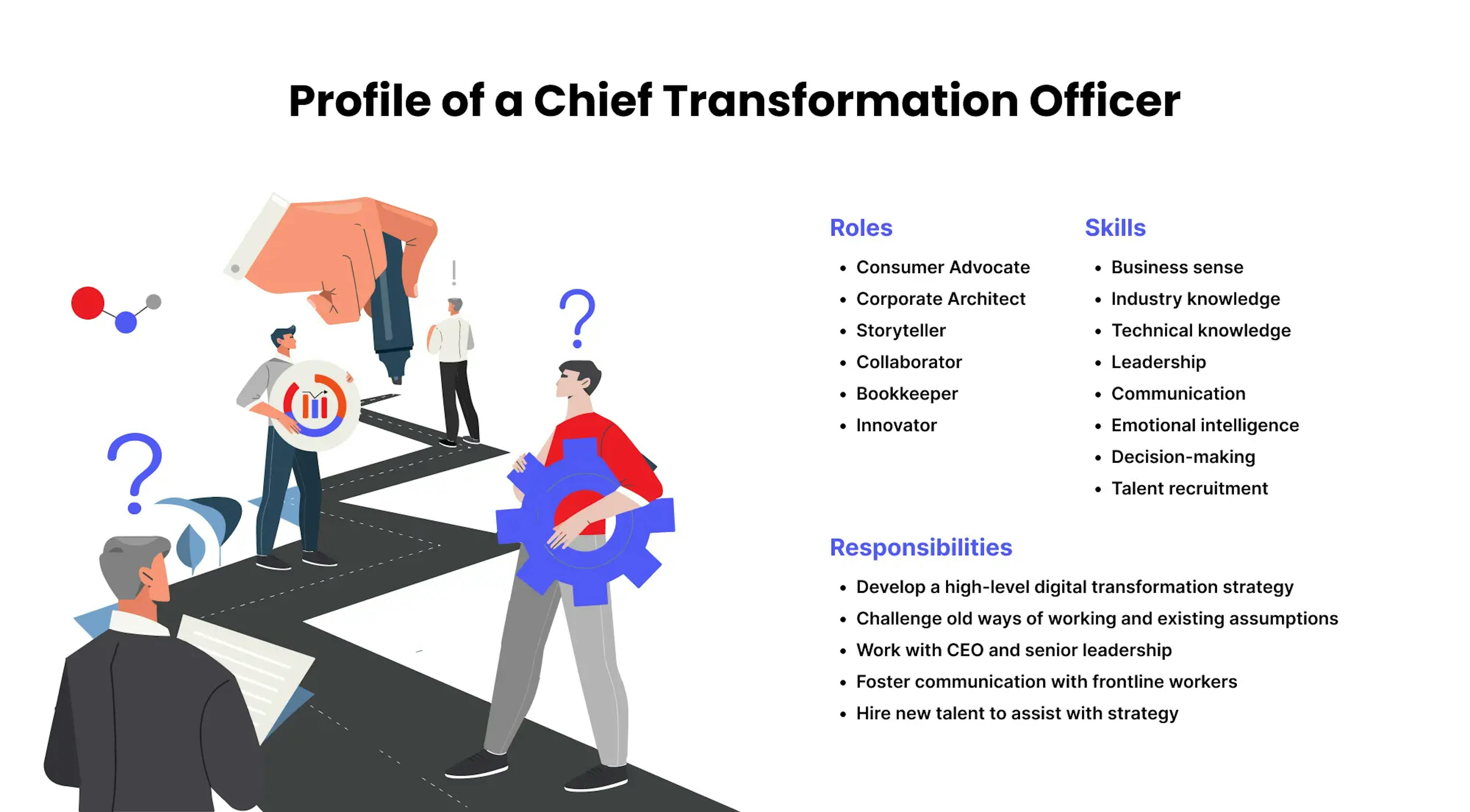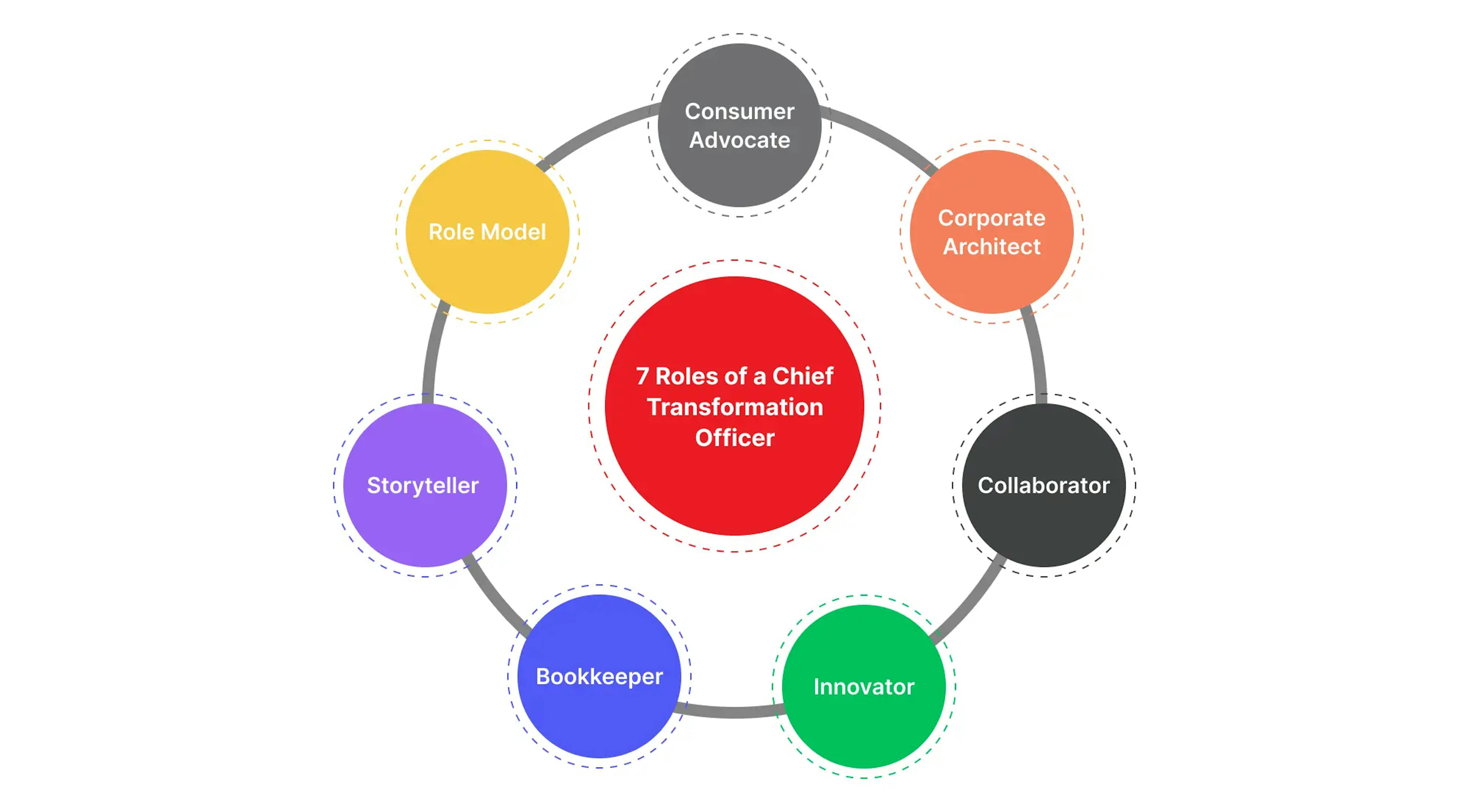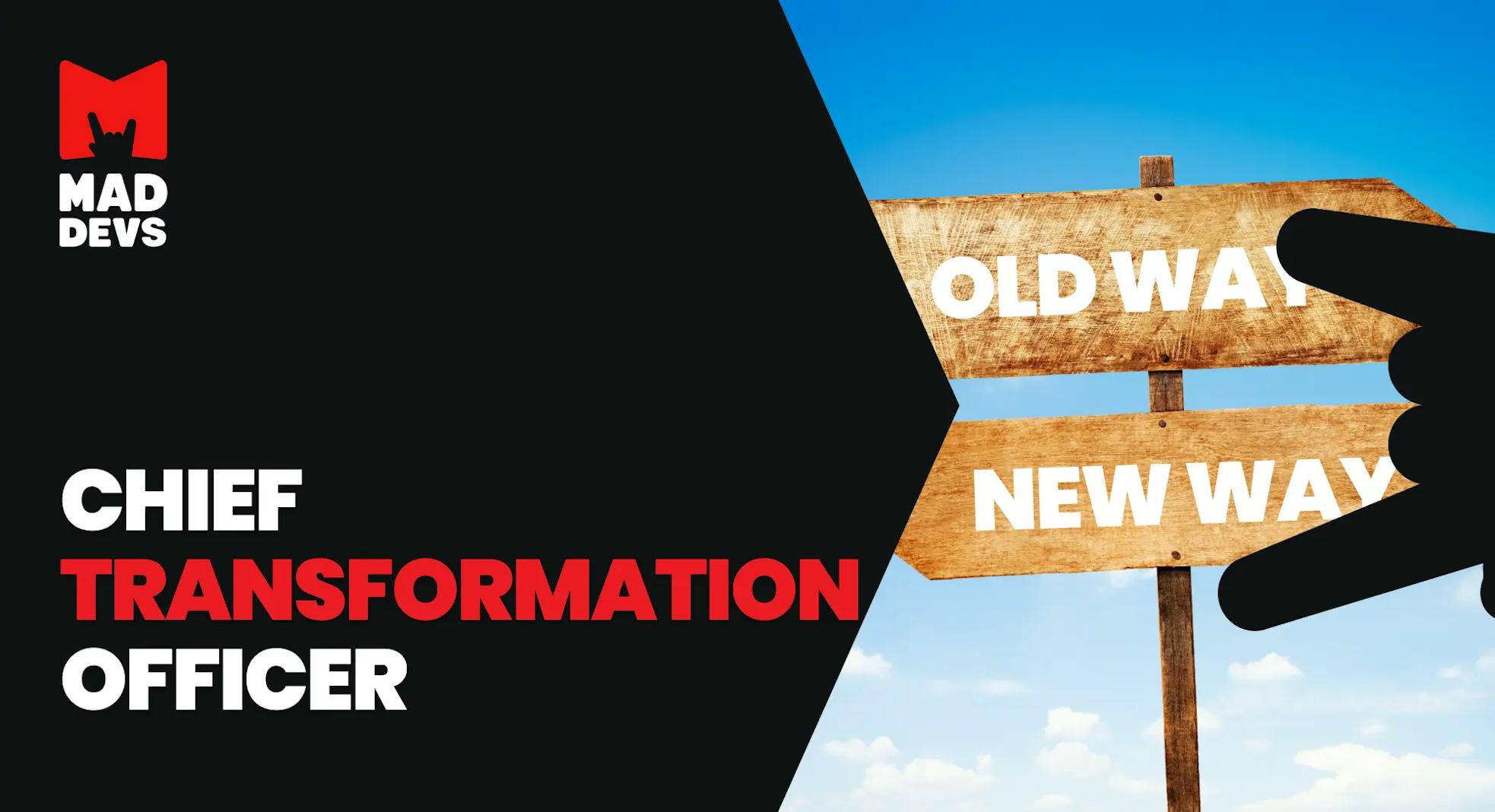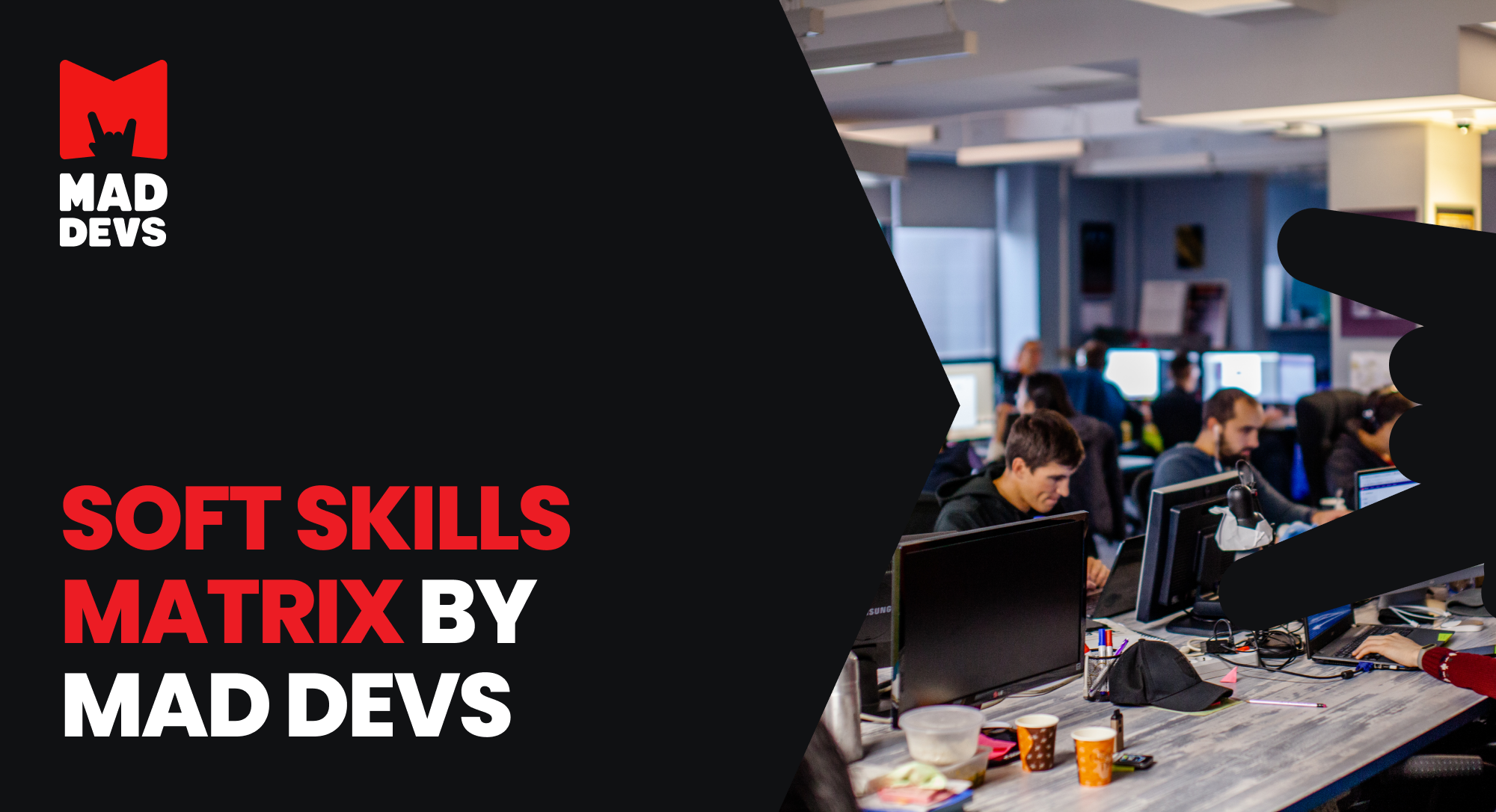A new job title has started circulating recently—chief transformation officer (CTO). This article will discuss how a chief transformation officer shouldn't be confused with a chief technology officer, also known as a CTO. This term has been used for some time in public-sector organizations, but it is relatively new in the private sector.
There is often rapid-fire development associated with it, particularly when it comes to digital transformation. Customer experience, business infrastructure, and continuous changes are usually included in the role.
In this article, we will discuss the role of the CTO in IT companies and how organizations can empower this crucial position to drive holistic change.
What is a chief transformation officer (CTO)?
As we mentioned above, the chief transformation officer (CTO) is an executive role, often in the C-suite, that focuses on bringing change, revenue, and profit growth to an organization. Many large and mid-size companies have added chief transformation officers to their teams as rapid-fire technological developments—along with shifting markets, customer demands, competitive environments, and trends in global trade—have spurred the need for continuous transformation and transformational leadership.
What does the chief transformation officer do?
CTOs are often involved in selecting new products and services. They also help optimize business processes, such as selling, marketing, communications, collaboration, and innovation. All digital transformation and change management efforts would also fall under the chief transformation officer.

Effective chief transformation officers inspire employees and serve as role models for the behaviors required for organizational change.
The chief transformation officer oversees the making and executing of responsibility and accountability for day-to-day decisions to ensure that the job gets done efficiently. A CTO is responsible for building people, data, and infrastructure synergies.
Along with helping teams and business leaders understand how to bring about transformational change, CTOs must keep top executives, including the CEO, informed about the changes needed.
To fully reap the benefits of digital transformation, the transformation chief should be integrated into the executive team.
Why is the role of the chief transformation officer important?
The CTO plays several roles, including the following:
- Guides the company's digital and business transformation efforts;
- Develops and implements strategies for improving operational efficiency, effectiveness, and competitiveness;
- Drives growth initiatives for a company.
Companies rely on CTOs to challenge the status quo. They prepare the company for the future by implementing digital transformation and disruption.
Digital transformation is hampered by employees who hold onto outdated processes. To achieve digital transformation, CTOs must dismantle old approaches and ways of thinking.
For transformation to be successful, the CTO must hold managers accountable. By using cross-functional teams, they encourage managers to adopt new approaches and embrace large-scale change. As part of their digital transformation efforts, they connect the perspective and vision of frontline teams to their overarching strategy.
The CTO is also responsible for coaching senior leadership, such as the CEO and board of directors, on digital transformation as part of their C-suite role.
What are key chief transformation officer tasks?
With businesses evolving rapidly, the new C-suite role is gaining popularity. The role of the CTO varies depending on the scale of the company. Plus, it depends on the nature of the transformation that the executive is responsible for.
CTOs should be prepared to facilitate or oversee the following tasks to mobilize resources successfully and enable connections.
Mapping the customer journey. Analyze and map the customer journey to understand its impact.
Designing a business model. Learn what customers expect and what they will pay for. As part of this, you should have a solid foundation in competitive intelligence and understand how disruptive competitors create value.
Architecture of the business. A CTO can better orchestrate changes when they have an overview of which individuals, teams, and their relationships.
Assessing capabilities. Determine whether the organization's resources are available and ready to be used. CTOS can prioritize investments to close capabilities gaps if they identify them upfront.
Instructing and communicating. Identify why a company needs to transform and scale a compelling narrative that explains why it needs to do so. Provide stakeholder education at all levels of the organization to complement it.
Scaling and incubation platforms. Platforms that enable scale, including data orchestration, should be provided.
Financing internal ventures. Assume the role of an internal venture capitalist. Set up a fund that is ring-fenced for efforts that promote cross-functional outcomes.
Using agile methods to work. The CTO acts as an internal venture capitalist. Invest in efforts that promote cross-functional outcomes by setting up a ring-fenced fund.
What skills and qualifications does a chief transformation officer need?
The CTO role description often includes many requirements because the CTO role requires many skills and qualifications, such as:
- Business sense. CTOs must have a deep knowledge of their business and its challenges.
- Industry knowledge. CTOs should have their finger on the pulse of current technology trends and emerging technologies.
- Emotional intelligence. Communication and interpersonal skills are essential for success.
- Leadership. To fulfill the team motivation function, CTO requires such qualities as guidance, modeling, and mentoring.
- Decision-making. To be successful in digital transformation programs, the CTO must be able to make data-driven decisions about resources, tasks, and deadlines.
- Strategic thinking. A CTO must see the big picture of a company's technological change. Furthermore, they must understand the challenges that business units face and how to address them.
- Talent awareness. CTOs should have a good sense for the people because they often must hire new talent to implement the change.
- Technical knowledge. The technical background of a CTO can help them understand the nuances of the frontline employees' technical difficulties.
Despite its streamlined position focusing exclusively on transformation, the CTO must juggle numerous roles to ensure a seamless transition.
One could see these various roles as overlapping efforts, a balance between them. Or they could be viewed as a progression, moving from one role to the next, all in the name of successfully transforming the business, processes, and culture.

Consumer advocate
Any business or organization has a customer, client, end user, etc. Before embarking on any transformational change within the organization, it is essential to consider how it will affect the consumer. The CTO can spearhead this effort.
Instead of merely considering the impact a transformation will have on a customer, a CTO would do well to consider the customer’s experience as the agent—the driver—for change:
- What do our customers need?
- How can we better serve these needs?
- How can we make the customer experience easier, more efficient, or truly outstanding?
Corporate architect
The CTO needs to know who the key players are, what they do, and how they are connected. To this end, you will map the company hierarchy and the department connections. This activity illustrates all of these connections so that you can better understand how a change in one department would affect another team and vice versa.
With this deep understanding of how each team contributes to the whole, you'll be able to visualize the optimal path to transformation.
Storyteller
It's important that CTO can write a compelling narrative about why the organization needs to change. Your story should have a beginning, a middle, and an end - a story that inspires people to act.
You must be able to articulate the specific goals of the transformation project clearly. It's up to you, CTO, to outline how these changes will help the company beat the competition or maintain your status as a competitive player in your market.
Collaborator
Once the CTO has laid out its story, it's time to get everyone on board. If the transition plan is to work, the CTO must work well with others.
They should connect with other C-suite members. These roles are critical to a smooth transition across the organization.
They also need to know the expectations of all internal stakeholders (board, financial advisors, investors, etc.). CTO's responsibility is to make contacts and build relationships with staff in the various departments.
Bookkeeper
Before embarking on large-scale change, CTO must assess your organization's resources and capabilities. It's not enough to know your strengths - you also need to know how to leverage them to facilitate change.
You also need to identify any gaps. Prioritize closing those gaps and streamlining operations. When you encounter hurdles, CTO must persistently overcome them without getting discouraged. In the name of improvement, an obstacle simply indicates what needs to be done.
In addition, the CTO must identify all available funding. Work closely with the chief financial officer (CFO) to ensure the right resources are available for the transformation and that budgets are being met.
Innovator
Any company anticipating change will be light years ahead of its competitors who are waiting for change to come to them. As CTO, you need to stay ahead of the curve. Not only do you need to anticipate the changes and innovations that are coming, but you also need to take the lead and make them happen.
Role model
The CTO is capable of being both the motivation for change and the reward for it. If CTO is willing to get involved, do the work, and get their hands dirty, people are more likely to feel motivated to be an active part of the team. As CTO, you should model what your colleagues and employees expect
Do you need a chief transformation officer in your business?
The answer to this depends on the size and scale of the business change you’re looking to implement and the budget you have to do this. Whether or not you recruit someone at the C-suite level, it is useful to have some resource dedicated to change if you run a scaling business that requires consistent change.
An important benefit of a CTO, or similar position, is that they become instrumental in driving change. As a result, they bridge the gap between your business strategy and the changes that need to be made to support it.
Here are some alternatives to hiring a CTO if your budget cannot cover it:
One person should manage the day-to-day actions and activities of the leadership change strategy, reporting progress to the leadership team. You must make sure to gather a lot of thoughts and opinions from different levels within the organization. To track progress, develop clear processes and scorecards.
Implement a change committee. You can benchmark change incentives by putting together a committee with people from different layers and departments within your business, then distribute actions among the group, allowing you to gain traction quicker.
Utilise external support in the form of a qualified change consultant. Choosing a change consultant who can integrate into a business over time is the key to this option. As a result, they will be able to help with strategy and be part of the implementation and measure success. In contrast to some traditional consultants who cannot drive deep change, this will enable you to work with most clients over at least six to twelve months to support them in integrating real, sustained culture change.
Digital transformation case study with CTO
Understanding an organization’s readiness for change is the fundamental building block for all successful transformations. Companies must systematically assess the preparedness of leaders, employees, and the transformation program.
Today's organizations are at different stages of transformation. You're not alone if you feel stuck in your transformation efforts. It can be challenging to overcome initial obstacles. If you are ready for it, contact us.
Not so long ago, an International Trade Center (ITC) asked to improve the Export Management Coaching Initiative (EMCI) implementation. By using this application, expert coaches in the field of export management train the owners of local enterprises on how to optimize business processes best.

The following results were achieved by updating and using the web app:
- Better reporting and coordination. Using the web application, coaches and SMEs track their activities electronically, generating valuable data that can be analyzed and distributed quickly and easily. Planning and implementing the project and missions became significantly easier and faster.
- Eco-friendly alternative. Using this digital tool can also help prevent the extensive use of paper in future projects.
- Saving time tool. R4TCA coaches can focus on collaborating and coaching SMEs instead of filling out hundreds of pages of paper-based manuals. Coaches were also provided a user guide through the web application's functions.
- Analyzing collected data. The unified regional data collection platform made adding, storing, processing, and sharing data easy, convenient, and accessible for analysis.
- Locally developed platform. The overall goal of the R4TCA project is to promote economic development in the Central Asian region. Therefore, it was only natural to choose Mad Devs, a development team whose developers are based in the region.
- Sustainability. Sustainability is one of the key paradigms of the R4TCA project. The digital transformation efforts initiated by the ITC have contributed significantly to sustainability in two ways through the innovative efforts of Mad Devs.
This cooperation has positively impacted the R4TCA's work, as much paperwork has been removed from their work processes. In addition, due to technical innovations, the application is stable, and the backend structure allows for future modifications and augmentations, making the app scalable and adaptable.
We appreciate that the team took the time to listen to us and to understand our needs. We also liked the professional approach. We hope we’ll work together again in the future.
Bottom line
The CTO's role is to oversee an organization's transformation efforts. Moreover, it includes working with senior leaders to develop and implement strategies to improve performance, employee satisfaction, and customer satisfaction. While the challenges of being a chief transformation officer can be significant, the rewards can be great for those who are up to the task.













